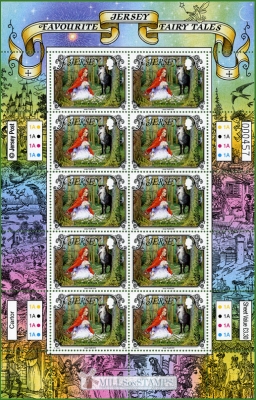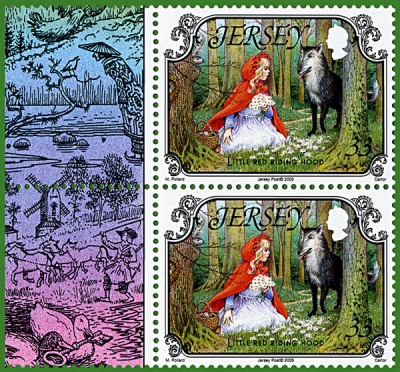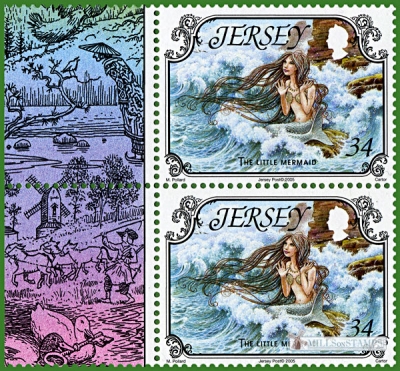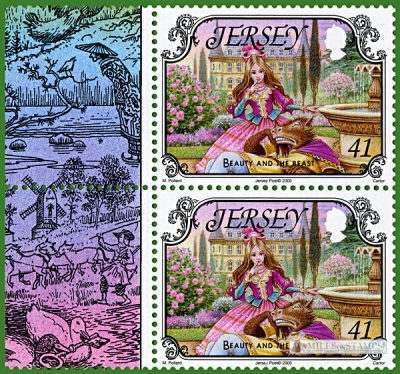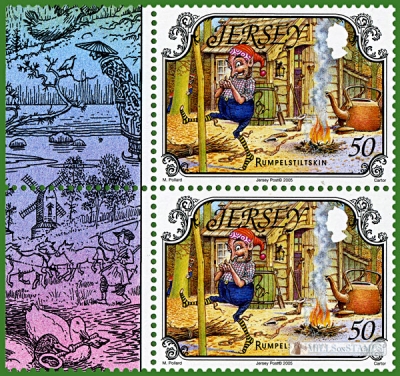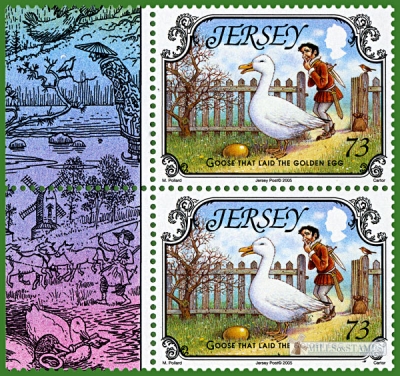-
Favourite Jersey Fairy tales
Jersey 2005.04.02
In issue: Stamp(s): 5 Souvenir sheet(s): 1
Printing: multicolor
Issued in: sheets of 10 (2*5) stamps
-
Number by catalogue: Yvert: 1205 Scott: 1156 Gibbons: 1140
Perforation type: 13x13 ¼
Subject:
The stamps of this issue do not contain the mills. But on each sheet of stamps there is a windmills on the left side.
33 pences. "Little Red Riding Hood"* by C. Perrault
Additional:
*"Little Red Riding Hood", also known as "Little Red Cap", is a famous fairy tale about a young girl and a big bad wolf. The story has been changed considerably in its history and subject to numerous modern adaptations and readings.
The tale:
It is about a girl called Little Red Riding Hood, after the red hooded cape or cloak she wears. The girl walks through the woods to deliver food to her sick grandmother.
A wolf wants to eat the girl but is afraid to do so in public. He approaches the girl, and she naïvely tells him where she is going. He suggests the girl pick some flowers, which she does. In the meantime, he goes to the grandmother's house and gains entry by pretending to be the girl. He swallows the grandmother whole, and waits for the girl, disguised as the grandmother.
When the girl arrives, she notices he looks very strange to be her grandma. In most retellings, this eventually culminates with Little Red Riding Hood saying, "My, what big teeth you have!"
To which the wolf replies, "The better to eat you with," and swallows her whole, too.
A hunter, however, comes to the rescue and cuts the wolf open. Little Red Riding Hood and her grandmother emerge unharmed. They fill the wolf's body with heavy stones, which drown him when he falls into a well. Other versions of the story have had the grandmother shut in the closet instead of eaten, and some have Little Red Riding Hood saved by the hunter as the wolf advances on her rather than after she is eaten.
The tale makes the clearest contrast between the safe world of the village and the dangers of the forest, conventional antitheses that are essentially medieval, though no written versions are as old as that.***Topics: Windmills
-
Number by catalogue: Yvert: 1206 Scott: 1157 Gibbons: 1141
Perforation type: 13x13 ¼
Subject:
34 pences. "The Little Mermaid" by H. C. Andersen
Additional:
*"The Little Mermaid" (Danish: Den lille havfrue) is a fairy tale by the Danish poet and author Hans Christian Andersen about a young mermaid willing to give up her life in the sea and her identity as a mermaid to gain a human soul and the love of a human prince. The tale was first published in 1837.
Plot:
The Little Mermaid lives in a utopian underwater kingdom with her father the sea king; her grandmother; and her five elder sisters, born one year apart. When a mermaid turns 15, she is allowed to swim to the surface to watch the world above, and as the sisters become old enough, one of them visits the surface every year. As each of them returns, the Little Mermaid listens longingly to their descriptions of the surface and of human beings.
When the Little Mermaid's turn comes, she ventures to the surface, sees a ship with a handsome prince, and falls in love with him from a distance. A great storm hits, and the Little Mermaid saves the prince from a near-drowning. She delivers him unconscious to the shore near a temple. Here she waits until a young girl from the temple finds him. The prince never sees the Little Mermaid.
The Little Mermaid asks her grandmother whether humans can live forever if they do not drown. The grandmother explains that humans have a much shorter lifespan than merfolk's 300 years, but that when mermaids die they turn to sea foam and cease to exist, while humans have an eternal soul that lives on in Heaven. The Little Mermaid, longing for the prince and an eternal soul, eventually visits the Sea Witch, who sells her a potion that gives her legs, in exchange for her tongue (as the Little Mermaid has the most intoxicating voice in the world). Drinking the potion will make her feel as if a sword is being passed through her, yet when she recovers she will have two beautiful legs, and will be able to dance like no human has ever danced before. However, it will constantly feel like she is walking on sharp swords, and her feet will bleed most terribly. In addition, she will only get a soul if the prince loves her and marries her, for then a part of his soul will flow into her. Otherwise, at dawn on the first day after he marries another woman, the Little Mermaid will die brokenhearted and disintegrate into sea foam.
The Little Mermaid drinks the potion and meets the prince, who is attracted to her beauty and grace even though she is mute. Most of all he likes to see her dance, and she dances for him despite her excruciating pain. When the prince's father orders his son to marry the neighboring king's daughter, the prince tells the Little Mermaid he will not, because he does not love the princess. He goes on to say he can only love the young woman from the temple, who he believes rescued him, but adds that the Little Mermaid is beginning to take the temple girl's place in his heart. It turns out that the princess is the temple girl, who had been sent to the temple to be educated. The prince loves her and the wedding is announced.
The prince and princess marry, and the Little Mermaid's heart breaks. She thinks of all that she has given up and of all the pain she has suffered. She despairs, thinking of the death that awaits her, but before dawn, her sisters bring her a knife that the Sea Witch has given them in exchange for their long hair. If the Little Mermaid slays the prince with the knife and lets his blood drip on her feet, she will become a mermaid again, all her suffering will end and she will live out her full life.
The Little Mermaid cannot bring herself to kill the sleeping prince lying with his bride and, as dawn breaks, throws herself into the sea. Her body dissolves into foam, but instead of ceasing to exist, she feels the warmth of the sun; she has turned into a spirit, a daughter of the air. The other daughters of the air tell her she has become like them because she strove with all her heart to gain an eternal soul. She will earn her own soul by doing good deeds, and she will eventually rise up into the kingdom of God.***Topics: Windmills
-
Number by catalogue: Yvert: 1207 Scott: 1158 Gibbons: 1142
Perforation type: 13x13 ¼
Subject:
41 pences. "Beauty and the Beast", by Jeanne Marie Leprince de Beaumont
Additional:
*Beauty and the Beast (French: La Belle et la Bête) is a traditional fairy tale (type 425C – enchanted husband – in the Aarne-Thompson classification). The first published version of the fairy tale was a rendition by Madame Gabrielle-Suzanne Barbot de Villeneuve, published in La jeune américaine, et les contes marins in 1740. The best-known written version was an abridgement of Mme Villeneuve's work published in 1756 by Mme Jeanne-Marie Le Prince de Beaumont, in Magasin des enfants, ou dialogues entre une sage gouvernante et plusieurs de ses élèves; an English translation appeared in 1757.
***
Plot:
A wealthy merchant lived in a mansion with his three daughters, all of whom were very beautiful, but only the youngest, age 14, is named Belle (French for "beautiful," "La Belle" means "The Beautiful [person]") for being lovely and pure of heart. The merchant eventually loses all of his wealth in a tempest at sea, and he and his daughters must therefore live in a small farmhouse and work for their living. After some years of this, the merchant hears that one of the trade ships sent by himself had arrived in port, having escaped the destruction of its compatriots; therefore he returns to the city to discover whether it contains anything of monetary value. Before leaving, he asks his daughters whether they desire that he bring them any gift upon his return. His two elder daughters ask for jewelry and fine dresses, thinking that his wealth has returned; Belle is satisfied with the promise of a rose, as none grow in their part of the country. The merchant finds that his ship's cargo has been seized to pay his debts, leaving him without money by which to buy his daughters their presents.
During his return, he becomes lost in a forest. Seeking shelter, he enters a castle. He finds inside tables laden with food and drink, which have apparently been left for him by the castle's owner. The merchant accepts this gift and is about to leave when he sees a rose garden and recalls that Belle had desired a rose. Upon picking the most lovely rose he finds, the merchant is confronted by a hideous 'Beast', which tells him that for taking his (the Beast's) most precious possession after accepting his hospitality, the merchant must stay his prisoner forever. The merchant begs to be set free, arguing that he had only picked the rose as a gift for his youngest daughter. The Beast agrees to let him go only if the merchant will send his daughter to live in the castle in his place.
The merchant is upset, but accepts this condition. He tries, upon arriving home, to hide the secret from Belle; but she pries it from him and willingly goes to the Beast's castle. The Beast receives her graciously and treats her as his guest. He gives her lavish clothing and food and carries on lengthy conversations with her. Each night, the Beast asks Belle to marry him, only to be refused each time. After each refusal, Belle dreams of a handsome prince who pleads with her to answer why she keeps refusing him, and she replies that she cannot marry the prince because she loves him only as a friend. Belle does not make the connection between the handsome prince and the Beast and becomes convinced that the Beast is holding the prince captive somewhere in the castle. She searches for him and discovers multiple enchanted rooms, but of course, never the prince from her dreams.
For several months Belle lives a life of luxury at the Beast's palace, being waited on hand and foot by invisible servants, having no end of riches to amuse her and an endless supply of exquisite finery to wear. Yet eventually, she becomes homesick and begs the Beast to allow her to go to see her family. He allows it, if she will return exactly a week later. Belle agrees to this and sets off for home with an enchanted mirror and ring. The mirror allows her to see what is going on back at the Beast's castle, and the ring allows her to return to the castle in an instant when turned three times around her finger. Her older sisters are surprised to find her well fed and dressed in finery. They grow jealous of her happy life at the castle, and, hearing that she must return to the Beast on a certain day, beg her to stay another day, even putting onion in their eyes to make it appear as though they are weeping. It is their wish that the Beast will grow angry with Belle for breaking her promise and will eat her alive. Belle's heart is moved by her sisters' show of love, and she agrees to stay.
Belle begins to feel guilty about breaking her promise to the Beast and uses the mirror to see him back at the castle. She is horrified to discover that the Beast is lying half-dead of heartbreak near the rose bushes her father had stolen from and she immediately uses the ring to return to Beast.
By the time Belle finds the Beast he is already dead, and she weeps over him, saying that she loves him. When her tears strike him, the Beast comes back to life and is transformed into a handsome prince, aged 24. The Prince informs Belle that long ago a fairy turned him into a hideous beast after he refused to let her in from the rain, and that only by finding true love, despite his ugliness, could he break the curse. He and Belle are married and happily live their lives.***Topics: Windmills
-
Number by catalogue: Yvert: 1208 Scott: 1159 Gibbons: 1143
Perforation type: 13x13 ¼
Subject:
50 pences. "Rumpelstiltskin"*, by the Brothers Grimm
Additional:
*Rumpelstiltskin is a character in a fairy tale of the same name that originated in Germany (where he is known as Rumpelstilzchen). The tale was collected by the Brothers Grimm, who first published it in the 1812 edition of Children's and Household Tales. It was subsequently revised in later editions until the final version was published in 1857.
Plot:
In order to make himself appear more important, a miller/commoner lied to the king that his daughter could spin straw into gold. The king called for the girl, shut her in a tower room with straw and a spinning wheel, and demanded that she spin the straw into gold by morning, for three nights, or be executed. She had given up all hope, when a dwarfish creature appeared in the room and spun straw into gold for her in return for her necklace; then again the following night for her ring. On the third night, when she had nothing with which to reward him, the strange creature spun straw into gold for a promise that the girl's first-born child would become his.
The king was so impressed that he married the miller's daughter, but when their first child was born, the dwarf returned to claim his payment: "Now give me what you promised". The queen was frightened and offered him all the wealth she had if she could keep the child. The dwarf refused but finally agreed to give up his claim to the child if the queen could guess his name in three days. At first she failed, but before the final night, her messenger discovered the dwarf's remote mountain cottage and, unseen, overhears the dwarf hopping about his fire and singing. While there are many variations in this song, the 1886 translation by Lucy Crane reads:
"To-day do I bake, to-morrow I brew,
The day after that the queen's child comes in;
And oh! I am glad that nobody knew
That the name I am called is Rumpelstiltskin!"
When the dwarf came to the queen on the third day and she revealed his name, Rumpelstiltskin lost his bargain. In the 1812 edition of the Brothers Grimm tales, Rumpelstiltskin then "ran away angrily, and never came back". The ending was revised in a final 1857 edition to a more gruesome version where Rumpelstiltskin "in his rage drove his right foot so far into the ground that it sank in up to his waist; then in a passion he seized the left foot with both hands and tore himself in two." Other versions have Rumpelstiltskin driving his right foot so far into the ground that he creates a chasm and falls into it, never to be seen again. In the oral version originally collected by the brothers Grimm, Rumpelstiltskin flies out of the window on a cooking ladle (Heidi Anne Heiner).***Topics: Windmills
-
Number by catalogue: Yvert: 1209 Scott: 1160 Gibbons: 1144
Perforation type: 13x13 ¼
Subject:
73 pences. "The Goose That Laid the Golden Eggs", by Aesop*
Additional:
*The Goose That Laid the Golden Eggs is one of many fables attributed to Aesop. It is very popular, as are many of his fables, which also include The Fox and the Grapes, The Boy Who Cried Wolf, and The Tortoise and the Hare.
Aesop (also spelled Æsop or Esop, from the Greek Αἴσωπος—Aisōpos) (ca. 620-564 BC), known for the genre of fables ascribed to him, was by tradition born a slave (δούλος) and was a contemporary of Croesus and Solon in the mid-sixth century BC in ancient Greece.
Story:
A man and his wife had the good fortune to possess a goose which laid a golden egg every day. Lucky though they were, they soon began to think they were not getting rich fast enough, and, imagining the bird must be made of gold inside, they decided to kill it. Then, they thought, they could obtain the whole store of precious metal at once; however, upon cutting the goose open, they found its innards to be like that of any other goose.
********
***This information has been taken from Wikipedia
Topics: Windmills


